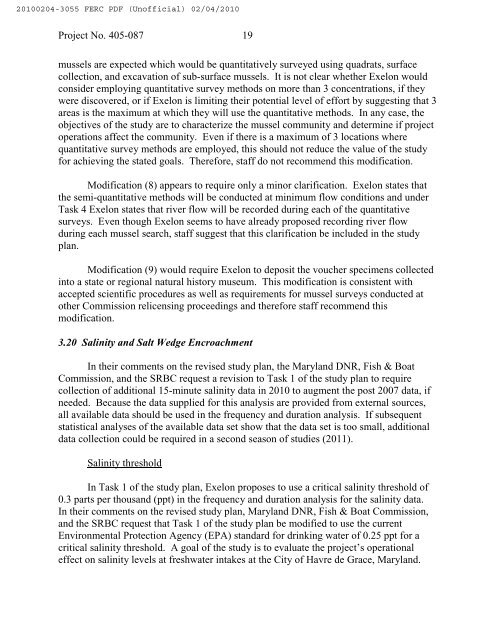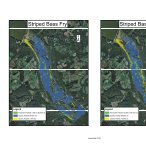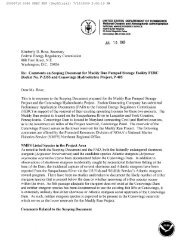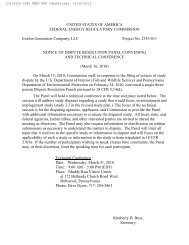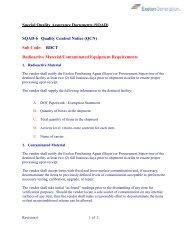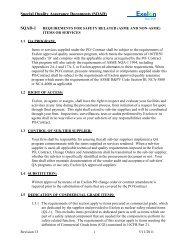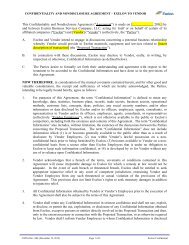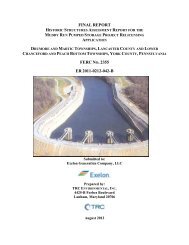FEDERAL ENERGY REGULATORY COMMISSION Project No. 405 ...
FEDERAL ENERGY REGULATORY COMMISSION Project No. 405 ...
FEDERAL ENERGY REGULATORY COMMISSION Project No. 405 ...
Create successful ePaper yourself
Turn your PDF publications into a flip-book with our unique Google optimized e-Paper software.
20100204-3055 FERC PDF (Unofficial) 02/04/2010<br />
<strong>Project</strong> <strong>No</strong>. <strong>405</strong>-087 19<br />
mussels are expected which would be quantitatively surveyed using quadrats, surface<br />
collection, and excavation of sub-surface mussels. It is not clear whether Exelon would<br />
consider employing quantitative survey methods on more than 3 concentrations, if they<br />
were discovered, or if Exelon is limiting their potential level of effort by suggesting that 3<br />
areas is the maximum at which they will use the quantitative methods. In any case, the<br />
objectives of the study are to characterize the mussel community and determine if project<br />
operations affect the community. Even if there is a maximum of 3 locations where<br />
quantitative survey methods are employed, this should not reduce the value of the study<br />
for achieving the stated goals. Therefore, staff do not recommend this modification.<br />
Modification (8) appears to require only a minor clarification. Exelon states that<br />
the semi-quantitative methods will be conducted at minimum flow conditions and under<br />
Task 4 Exelon states that river flow will be recorded during each of the quantitative<br />
surveys. Even though Exelon seems to have already proposed recording river flow<br />
during each mussel search, staff suggest that this clarification be included in the study<br />
plan.<br />
Modification (9) would require Exelon to deposit the voucher specimens collected<br />
into a state or regional natural history museum. This modification is consistent with<br />
accepted scientific procedures as well as requirements for mussel surveys conducted at<br />
other Commission relicensing proceedings and therefore staff recommend this<br />
modification.<br />
3.20 Salinity and Salt Wedge Encroachment<br />
In their comments on the revised study plan, the Maryland DNR, Fish & Boat<br />
Commission, and the SRBC request a revision to Task 1 of the study plan to require<br />
collection of additional 15-minute salinity data in 2010 to augment the post 2007 data, if<br />
needed. Because the data supplied for this analysis are provided from external sources,<br />
all available data should be used in the frequency and duration analysis. If subsequent<br />
statistical analyses of the available data set show that the data set is too small, additional<br />
data collection could be required in a second season of studies (2011).<br />
Salinity threshold<br />
In Task 1 of the study plan, Exelon proposes to use a critical salinity threshold of<br />
0.3 parts per thousand (ppt) in the frequency and duration analysis for the salinity data.<br />
In their comments on the revised study plan, Maryland DNR, Fish & Boat Commission,<br />
and the SRBC request that Task 1 of the study plan be modified to use the current<br />
Environmental Protection Agency (EPA) standard for drinking water of 0.25 ppt for a<br />
critical salinity threshold. A goal of the study is to evaluate the project’s operational<br />
effect on salinity levels at freshwater intakes at the City of Havre de Grace, Maryland.


